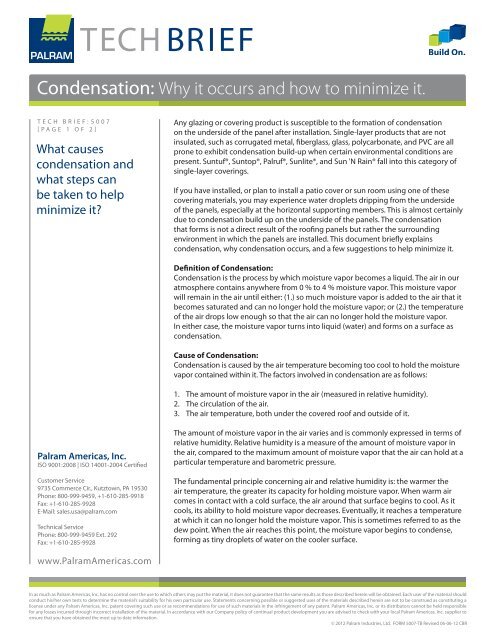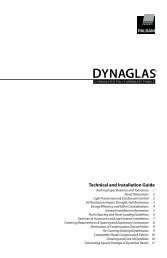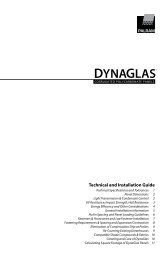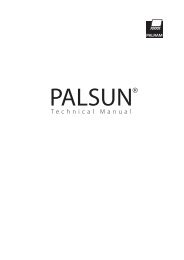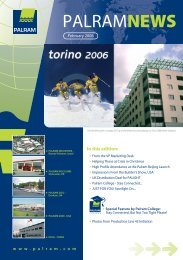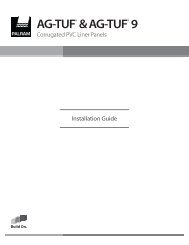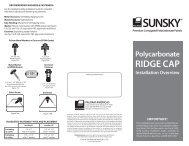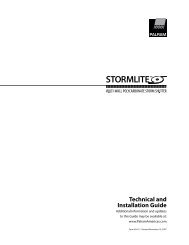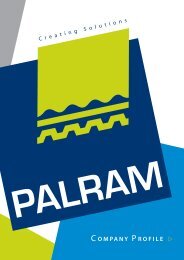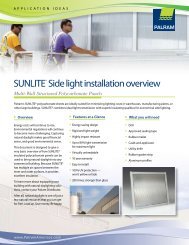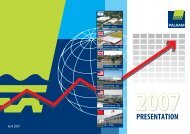Tech Brief 5007: Condensation - Palram Americas
Tech Brief 5007: Condensation - Palram Americas
Tech Brief 5007: Condensation - Palram Americas
- No tags were found...
You also want an ePaper? Increase the reach of your titles
YUMPU automatically turns print PDFs into web optimized ePapers that Google loves.
TECH BRIEF<strong>Condensation</strong>: Why it occurs and how to minimize it.TECH BRIEF: <strong>5007</strong> Any glazing or covering product is susceptible to the formation of condensation[PAGE 1 OF 2]on the underside of the panel after installation. Single-layer products that are notinsulated, such as corrugated metal, fiberglass, glass, polycarbonate, and PVC are allprone to exhibit condensation build-up when certain environmental conditions arepresent. Suntuf®, Suntop®, Palruf®, Sunlite®, and Sun 'N Rain® fall into this category ofsingle-layer coverings.What causescondensation andwhat steps canbe taken to helpminimize it?If you have installed, or plan to install a patio cover or sun room using one of thesecovering materials, you may experience water droplets dripping from the undersideof the panels, especially at the horizontal supporting members. This is almost certainlydue to condensation build up on the underside of the panels. The condensationthat forms is not a direct result of the roofing panels but rather the surroundingenvironment in which the panels are installed. This document briefly explainscondensation, why condensation occurs, and a few suggestions to help minimize it.Definition of <strong>Condensation</strong>:<strong>Condensation</strong> is the process by which moisture vapor becomes a liquid. The air in ouratmosphere contains anywhere from 0 % to 4 % moisture vapor. This moisture vaporwill remain in the air until either: (1.) so much moisture vapor is added to the air that itbecomes saturated and can no longer hold the moisture vapor; or (2.) the temperatureof the air drops low enough so that the air can no longer hold the moisture vapor.In either case, the moisture vapor turns into liquid (water) and forms on a surface ascondensation.Cause of <strong>Condensation</strong>:<strong>Condensation</strong> is caused by the air temperature becoming too cool to hold the moisturevapor contained within it. The factors involved in condensation are as follows:1. The amount of moisture vapor in the air (measured in relative humidity).2. The circulation of the air.3. The air temperature, both under the covered roof and outside of it.<strong>Palram</strong> <strong>Americas</strong>, Inc.ISO 9001:2008 | ISO 14001-2004 CertifiedCustomer Service9735 Commerce Cir., Kutztown, PA 19530Phone: 800-999-9459, +1-610-285-9918Fax: +1-610-285-9928E-Mail: sales.usa@palram.com<strong>Tech</strong>nical ServicePhone: 800-999-9459 Ext. 292Fax: +1-610-285-9928The amount of moisture vapor in the air varies and is commonly expressed in terms ofrelative humidity. Relative humidity is a measure of the amount of moisture vapor inthe air, compared to the maximum amount of moisture vapor that the air can hold at aparticular temperature and barometric pressure.The fundamental principle concerning air and relative humidity is: the warmer theair temperature, the greater its capacity for holding moisture vapor. When warm aircomes in contact with a cold surface, the air around that surface begins to cool. As itcools, its ability to hold moisture vapor decreases. Eventually, it reaches a temperatureat which it can no longer hold the moisture vapor. This is sometimes referred to as thedew point. When the air reaches this point, the moisture vapor begins to condense,forming as tiny droplets of water on the cooler surface.www.<strong>Palram</strong><strong>Americas</strong>.comIn as much as <strong>Palram</strong> <strong>Americas</strong>, Inc. has no control over the use to which others may put the material, it does not guarantee that the same results as those described herein will be obtained. Each user of the material shouldconduct his/her own tests to determine the material’s suitability for his own particular use. Statements concerning possible or suggested uses of the materials described herein are not to be construed as constituting alicense under any <strong>Palram</strong> <strong>Americas</strong>, Inc. patent covering such use or as recommendations for use of such materials in the infringement of any patent. <strong>Palram</strong> <strong>Americas</strong>, Inc. or its distributors cannot be held responsiblefor any losses incurred through incorrect installation of the material. In accordance with our Company policy of continual product development you are advised to check with your local <strong>Palram</strong> <strong>Americas</strong>, Inc. supplier toensure that you have obtained the most up to date information.© 2012 <strong>Palram</strong> Industries, Ltd. FORM <strong>5007</strong>-TB Revised 06-06-12 CBR
TECH BRIEFTECH BRIEF: <strong>5007</strong> To help you visualize this more clearly, we point to an extreme example: a pot of[PAGE 2 OF 2]heated water with a glass lid on top. As the water in the pot becomes heated, it turnsinto moisture vapor, ultimately becoming dense enough to be seen as steam. As themoisture vapor rises, it comes in contact with the lid. The moisture vapor cools andbegins to condense and collect on the underside of the lid, ultimately collecting intolarger and larger droplets that become too heavy and fall from the lid.A similar, but less extreme example would be how windows inside of a car becomefoggy. When someone gets into a cold car, and the temperature outside is also cold,they begin to warm the inside, and also begin to add moisture vapor to the air just bybreathing and naturally perspiring. As the moisture-laden air comes into contact withthe window, the air is cooled and condenses, forming a fog on the windows.Moisture vapor within a covered structure is much less visible, but is still presentand is susceptible to the same phenomenon. Warm, moisture-laden air will rise andcondense as it comes into contact with the underside of the panel, which is coolbecause its exterior is exposed to the cooler outdoor temperature.Air Circulation and <strong>Condensation</strong>:When air remains still, next to a cool surface, it cools down more rapidly than air that iswell-circulated. As the air temperature within a structure decreases, its ability to holdthe moisture vapor within in it decreases.Using our example of an automobile interior, when the defroster is turned on, it blowswarmed fresh air across the surface of the window, which warms the interior surfaceof the window, and circulates the air around the car, thereby slowing cooling of themoisture vapor, and preventing it from collecting on the surface of the car's windows.Supplying air circulation to the a covered roof area also slows down the coolingprocess and can help reduce condensation formation.Ways of Reducing <strong>Condensation</strong> on Your <strong>Palram</strong> Roof:1. Remove obstacles which inhibit proper air circulation under your <strong>Palram</strong> roof.2. The installation of an exterior-grade ceiling or circulation fan can create enough aircirculation to reduce the chances of condensation build up.3. In enclosed structures, the addition of a dehumidifier can assist in removingunwanted moisture it the air.The implementation of the above suggestions can help minimize unwanted moisturein the air of most applications. Nevertheless, it is impossible to account for allapplications and their surrounding environmental conditions.Applications in high humidity areas such as those in the Pacific Northwest orSoutheastern United States are more prone to condensation issues.If condensation drip is objectionable, it is recommended that these suggestions areput in place to support the removal of excess moisture vapor.<strong>Palram</strong> <strong>Americas</strong>, Inc.ISO 9001:2008 | ISO 14001-2004 Certifiedwww.<strong>Palram</strong><strong>Americas</strong>.comNote: It is possible to build structures with supports that are designed to collect and drain condensationfrom coverings in order to eliminate dripping. These structures are relatively complex to build and requirestructural supports that are not typically found through DIY sales channels. For more information, consultwith an architect or glazing engineer.


